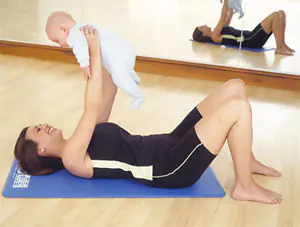Any exercises to contract the uterus are justified only with the knowledge of a doctor. Nature has already made sure that the body, exhausted by pregnancy and childbirth, gradually returns to normal life. The hormone oxytocin, which is normally released by a woman in labor and is associated with breastfeeding, is responsible for restoring the size of the pelvic organs. It also eases the psychological state of a young mother.
Already on the 14th day after birth, the uterus, the weight of which reached 1 kg, is approximately halved. The sensations are unpleasant, but quite natural. If there are no complications, then the process can be somewhat facilitated with the help of massage (in the form of ordinary stroking through the abdominal wall) and simple exercises. Light physical activity, such as walking, also promotes recovery.
Below are several techniques that will help restore the tone of the pelvic organs. They begin to practice the day after childbirth.
Content- Warm-up for the prevention of thrombosis:
- Breathing exercise to contract the uterus:
- After this, move on to strengthening your abdominal and back muscles.
Warm-up for the prevention of thrombosis:
- Lying on your back, bend and straighten your closed legs at a calm pace. To start, 10 repetitions are enough.
- Alternately curl and relax your toes.
- Straightening your legs, alternately stretch your toes towards you.
Breathing exercise to contract the uterus:
Lie on your back, bend your legs. Breathe evenly and deeply. Connect your abdominal muscles to breathing. As you inhale ㅡ rise, as you exhale ㅡ lower the abdominal wall, while helping yourself with a sliding movement of your hands from the navel to the pubic bone.
If you've had an episiotomy (and who hasn't?), this should be limited to until the stitch is completely healed. If there is no serious discomfort in the perineal area, you can do Kegel exercises. The easiest option is to alternately squeeze the muscles of the vagina and anus. It is important that these cuts are isolated from each other.
- As you exhale, squeeze your pelvic floor muscles while pulling your belly button toward your chest. Concentrate on the tension in your lower abdomen and, without stopping your breathing, try to hold it for 10 seconds. If possible, you should refrain from contracting other core muscles.
- For this exercise, a gymnastic ball on a non-slip surface will be useful. Sit on top and squeeze your pelvic floor and abdominal muscles below your waist. Lift one leg at a time. Hold this pose for 5-10 seconds. Breathe as usual.
- While continuing to sit on the ball, perform circular movements with your pelvis in both directions. It is also helpful to rock back and forth while reading or watching a movie.
Any physical activity, theoretically, increases blood circulation in the pelvic area, which is not very desirable in the first six to seven weeks after childbirth, while the uterine cavity is a wounded surface. But after this period, after the cessation of lochia, you can move on to full physical exercise at home or in the fitness room.
Post Views: 76


